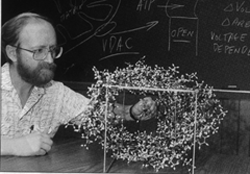

Dept. of Biology
University of Maryland
College Park, Maryland 20742
email: colombini@umd.edu
phone: (301) 405-6925

|

|
Dept. of Biology University of Maryland College Park, Maryland 20742 email: colombini@umd.edu phone: (301) 405-6925 |
Research Interest: Membrane Transport Phenomena
The broad objective of Dr. Colombini's research is to understand how the molecular machines, that drive the life processes in cells, work. He has focused on the macromolecules, mainly proteins, that are lodged within cell membranes and translocate molecules and ions across the membranes. An important unanswered question under current active investigation by Dr. Colombini, his collaborators, and his students is the molecular mechanism underlying the voltage control of membrane channels. Channel-forming proteins that are under voltage control are responsible for such processes as action potentials, muscle excitation, hormone release, and the control of egg fertilization. The channel-former being studied in Dr. Colombini's laboratory is called VDAC (pronounced vedak). It is located in the mitochondrial outer membrane and may control most of the energy production in animal cells. VDAC has also been implicated as a step in the regulation of mitochondria-mediated apoptosis. Other research is focusing on the biophysics of channel formation two other classes of channel-formers: ceramides and their role in apoptosis and bacterial channels, called porins, from cells responsible for meningitis.
The research is highly interdisciplinary and includes growing and harvesting cells, isolating and purifying cell organelles, purifying soluble and membrane proteins, reconstituting proteins into vesicles and planar phospholipid membranes, making electrophysiological recordings on individual channel-forming molecules as well as ensembles of molecules, electron-microscopic studies of channel-forming proteins both by negative staining and freeze-fracture, and studies of genetically-modified channels.
Dr. Colombini is committed to training students to become critical thinkers. Their specific training centers on the phenomena, processes, and forces that relate to membrane function. However, the training is approached at a fundamental level which makes it generally applicable to all cellular functions. Students are encouraged to broaden their horizons further as their interests dictate.
Awards and Honors:
Meller Basic Medical Research Award, 1976
College of Life Sciences Faculty Award for Excellence in Research, 1995
Selected Recent Publications:
-Regulation
of VDAC and mitochondrial outer membrane permeability
-Metabolite
flux through VDAC
-Auto-directed
insertion of VDAC into phospholipid membranes
-Recent
reviews
-Biophysical
studies on Meningococcal porins
-Structure
and voltage-gating of VDAC
-Apoptosis:
the roles of VDAC and Ceramide
-VDAC:
Ion permeation and generation of current noise
Class
Data Files
VDAC web page
QBasic
file to fit data and determine outer membrane permeability to ADP